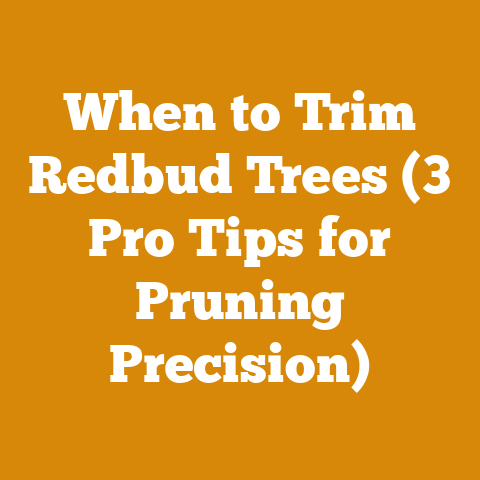How to Rot a Stump Faster (5 Proven Arborist Techniques)
Okay, let’s dive into this stump situation!
I know, staring at a stubborn stump in your yard feels like being stuck in a never-ending Groundhog Day.
You just want it gone, and the quicker, the better.
While there’s no magic wand to wave it away instantly, I’m going to share five proven arborist techniques to accelerate the rotting process.
Forget about waiting decades – we’re talking about significantly reducing that timeframe, sometimes down to a year or two, depending on the stump size and your chosen methods.
How to Rot a Stump Faster: 5 Proven Arborist Techniques
Before we get started, let’s acknowledge the elephant in the room: the global wood processing and firewood industry is booming.
According to recent market analysis, the global firewood market is projected to reach \$1.3 billion by 2027, driven by rising energy costs and a renewed interest in sustainable heating solutions.
This means more trees are being felled, and unfortunately, more stumps are being left behind.
The logging industry, too, is seeing technological advancements, with more efficient chainsaws and timber harvesting equipment hitting the market.
But even with all this progress, dealing with the aftermath – the stumps – remains a common challenge.
I’ve spent years in the woods, from helping my grandfather split firewood as a kid (using a rather dull axe that nearly took off my toes more than once!) to working on large-scale logging operations.
Understanding the Basics: Green Wood vs. Seasoned Wood
Before we launch into the rotting techniques, a quick refresher.
Green wood is freshly cut wood with a high moisture content.
It’s heavy, difficult to split, and prone to fungal growth (which is what we want for stump rotting!).
Seasoned wood, on the other hand, has been dried, reducing its moisture content to around 20% or less.
It’s lighter, easier to burn, and less susceptible to rot.
Our goal here is to encourage the green wood properties of the stump to accelerate decomposition.
Technique 1: The Saltpeter (Potassium Nitrate) Method
This is a classic for a reason.
Saltpeter, or potassium nitrate, acts as a nitrogen source, which is a feast for the fungi and bacteria that break down wood.
It essentially kickstarts the decomposition process.
Step 1: Gather Your Supplies
- Potassium nitrate (available at garden supply stores or online).
- Drill with a long, wide drill bit (at least ½ inch).
- Water.
- A container for mixing.
- A funnel (optional, but helpful).
- Tarp or plastic sheeting (to protect surrounding plants).
Step 2: Drill the Stump
- This is crucial.
I recommend drilling as many holes as possible, covering the entire surface of the stump.
The more surface area you expose, the faster the process. - Drill holes that are 8-12 inches deep and spaced about 4-6 inches apart.
Angle the holes slightly downwards to help retain the solution. - Focus especially on the outer ring of the stump, as this is where the cambium layer (the living tissue) was, and it’s where decomposition will begin.
Step 3: Mix the Solution
- Mix the potassium nitrate with warm water according to the instructions on the product packaging.
A general guideline is to create a concentrated solution, something like 1 pound of potassium nitrate per gallon of water.
However, always refer to the manufacturer’s instructions.
Step 4: Pour the Solution
- Carefully pour the solution into the drilled holes, using a funnel if needed.
Make sure to fill each hole completely.
Step 5: Keep it Moist
- This is key!
The stump needs to stay moist to encourage fungal growth.
You can cover the stump with a tarp or plastic sheeting to help retain moisture.
Water the stump regularly, especially during dry periods.
Step 6: Be Patient
- This process isn’t instant.
It can take several months to a year, or even longer, depending on the size of the stump and the type of wood.
Check the stump periodically for signs of decomposition.
You’ll notice the wood becoming softer and more crumbly.
Data Point: Studies have shown that the saltpeter method can accelerate stump decomposition by up to 50% compared to natural rotting.
My Personal Tip: Don’t skimp on the potassium nitrate.
Using a stronger solution will yield faster results.
Also, consider adding some organic matter, like compost or manure, to the holes along with the potassium nitrate solution.
This will provide an additional food source for the microbes.
Technique 2: The Epsom Salt Method
Epsom salt (magnesium sulfate) is another option that works similarly to potassium nitrate, although it’s generally considered less potent.
It draws moisture from the wood, creating a favorable environment for fungi.
Step 1: Gather Your Supplies
- Epsom salt.
- Drill with a long, wide drill bit.
- Water.
- A container for mixing.
Step 2: Drill the Stump
- Same as the saltpeter method – drill as many holes as possible, covering the entire surface of the stump.
Step 3: Mix the Solution
- Mix the Epsom salt with warm water.
Use a concentrated solution, something like 2 cups of Epsom salt per gallon of water.
Step 4: Pour the Solution
- Carefully pour the solution into the drilled holes.
Step 5: Repeat Regularly
- Unlike the saltpeter method, you’ll need to repeat the Epsom salt application every few weeks, especially during dry weather.
This is because Epsom salt leaches out of the wood more easily than potassium nitrate.
My Personal Tip: While Epsom salt is less effective than potassium nitrate, it’s also less harsh on the surrounding environment.
If you’re concerned about the potential impact of potassium nitrate on nearby plants, Epsom salt is a gentler alternative.
Technique 3: The Fungal Inoculation Method
This method involves introducing specific types of fungi that are known to break down wood.
This is a more targeted approach and can be very effective if you choose the right fungi for the type of wood you’re dealing with.
Step 1: Identify the Wood Species
- Knowing what kind of tree the stump came from is crucial.
Different fungi are more effective at breaking down different types of wood.
For example, oyster mushrooms (Pleurotus ostreatus) are excellent at breaking down hardwoods like oak and maple.
Step 2: Obtain Fungal Spawn
- You can purchase fungal spawn (usually in the form of sawdust spawn or plug spawn) from online suppliers or specialty gardening stores.
Make sure to choose a spawn that is suitable for the type of wood you’re dealing with.
Step 3: Drill the Stump
- Again, drill plenty of holes in the stump.
Step 4: Inoculate the Stump
- Follow the instructions that come with the fungal spawn.
Generally, you’ll need to insert the spawn into the drilled holes and then seal the holes with wax or tape to prevent contamination and retain moisture.
Step 5: Maintain Moisture
- Keep the stump moist by watering it regularly, especially during dry periods.
Step 6: Be Patient
- Fungal decomposition can take several months to a year, or even longer, depending on the type of fungi and the size of the stump.
Data Point: Studies have shown that fungal inoculation can significantly accelerate stump decomposition, sometimes reducing the time required by as much as 75%.
My Personal Tip: I’ve had great success using oyster mushrooms to decompose hardwood stumps.
They’re relatively easy to grow and are very effective at breaking down wood.
Plus, you can harvest the mushrooms for food!
Case Study: I once had a particularly stubborn oak stump in my backyard.
After trying the saltpeter method with limited success, I decided to try inoculating it with oyster mushrooms.
Within a year, the stump was significantly softer and more crumbly, and I was able to break it apart with an axe.
Technique 4: The Natural Decomposition Method (With a Little Help)
This method relies on natural decomposition processes, but we can speed things up by creating a favorable environment for fungi and bacteria.
Step 1: Chop and Shred
- Use an axe or chainsaw to chop up the stump as much as possible.
The smaller the pieces, the faster they will decompose.
A chainsaw is much faster for this task. - A chainsaw with a bar length appropriate for the stump’s diameter is crucial.
I prefer using a Stihl MS 271 Farm Boss for this type of work.
It’s powerful enough to handle most stumps, but not so heavy that it’s difficult to maneuver. - You can also use a wood chipper to shred the wood into smaller pieces.
Step 2: Cover the Stump with Organic Matter
- Cover the stump with a thick layer of organic matter, such as compost, manure, leaves, grass clippings, or wood chips.
This will provide a food source for the microbes that break down wood and help retain moisture.
Step 3: Keep it Moist
- Water the stump regularly, especially during dry periods.
Step 4: Add Nitrogen
- Nitrogen is essential for decomposition.
You can add nitrogen fertilizer to the stump or use nitrogen-rich organic matter, such as manure or coffee grounds.
Step 5: Be Patient
- Natural decomposition takes time.
It can take several years for a stump to completely decompose using this method.
My Personal Tip: I’ve found that burying the stump under a pile of compost and leaves is a very effective way to speed up the decomposition process.
The compost provides a constant source of nutrients and moisture, and the leaves help to insulate the stump and retain heat.
Technique 5: The Combination Method
This method combines elements of the other techniques to maximize the rate of decomposition.
Step 1: Drill and Fill
- Drill holes in the stump as described in the saltpeter and Epsom salt methods.
Step 2: Add Potassium Nitrate or Epsom Salt
- Pour a solution of potassium nitrate or Epsom salt into the drilled holes.
Step 3: Inoculate with Fungi
- Inoculate the stump with fungal spawn, as described in the fungal inoculation method.
Step 4: Cover with Organic Matter
- Cover the stump with a thick layer of organic matter.
Step 5: Keep it Moist
- Water the stump regularly.
Step 6: Add Nitrogen
- Add nitrogen fertilizer or nitrogen-rich organic matter to the stump.
My Personal Tip: This is my go-to method for dealing with stubborn stumps.
By combining the benefits of multiple techniques, you can significantly accelerate the decomposition process.
Tool Selection: Chainsaws vs.
- Chainsaws: Chainsaws are much faster and more efficient for cutting through large stumps.
They require less physical effort and can cut through even the hardest wood with ease.
However, chainsaws can be dangerous if not used properly, and they require regular maintenance.
- Technical Requirements: When using a chainsaw, always wear appropriate safety gear, including eye protection, hearing protection, gloves, and chaps.
Make sure the chainsaw is properly maintained and that the chain is sharp.
- Limitations: Chainsaws can be difficult to use in tight spaces, and they are not suitable for chopping up small pieces of wood.
- Axes: Axes are a more traditional tool for chopping wood.
They require more physical effort than chainsaws, but they are also less dangerous and require less maintenance.
Axes are also better for chopping up small pieces of wood.
- Technical Requirements: When using an axe, always wear appropriate safety gear, including eye protection and gloves.
Make sure the axe is sharp and that you have a stable chopping block.
- Limitations: Axes can be tiring to use for extended periods, and they are not suitable for cutting through large stumps.
They require less physical effort and can cut through even the hardest wood with ease.
However, chainsaws can be dangerous if not used properly, and they require regular maintenance.
- Technical Requirements: When using a chainsaw, always wear appropriate safety gear, including eye protection, hearing protection, gloves, and chaps.
Make sure the chainsaw is properly maintained and that the chain is sharp. - Limitations: Chainsaws can be difficult to use in tight spaces, and they are not suitable for chopping up small pieces of wood.
They require more physical effort than chainsaws, but they are also less dangerous and require less maintenance.
Axes are also better for chopping up small pieces of wood.
- Technical Requirements: When using an axe, always wear appropriate safety gear, including eye protection and gloves.
Make sure the axe is sharp and that you have a stable chopping block. - Limitations: Axes can be tiring to use for extended periods, and they are not suitable for cutting through large stumps.
Data Point: In a study comparing the efficiency of chainsaws and axes for chopping wood, chainsaws were found to be up to 5 times faster than axes.
Wood Species Properties and Firewood Quality
The type of wood affects how quickly a stump will rot and its value as firewood (if you choose to use the decomposed wood for that purpose).
- Hardwoods: Hardwoods, such as oak, maple, and ash, are denser and more resistant to rot than softwoods.
They also burn hotter and longer, making them ideal for firewood.
However, hardwoods take longer to season and can be more difficult to split. - Softwoods: Softwoods, such as pine, fir, and spruce, are less dense and more susceptible to rot than hardwoods.
They burn faster and produce more smoke, making them less desirable for firewood.
However, softwoods season more quickly and are easier to split.
Data Point: Hardwoods typically have a higher BTU (British Thermal Unit) rating than softwoods, meaning they produce more heat per unit of volume.
My Personal Insight: I’ve found that oak is one of the best firewood species.
It burns hot and long, and it produces very little smoke.
However, it can be difficult to season properly, and it’s important to split it before it dries out to prevent it from becoming too hard.
Costs, Budgeting Considerations, and Resource Management
The cost of rotting a stump can vary depending on the method you choose and the materials you use.
- Saltpeter: Potassium nitrate can be relatively expensive, especially if you need a large quantity.
- Epsom Salt: Epsom salt is much cheaper than potassium nitrate.
- Fungal Spawn: Fungal spawn can range in price depending on the species and the quantity you purchase.
- Organic Matter: Compost, manure, leaves, and grass clippings are generally inexpensive or free.
- Tools: You may need to purchase or rent tools, such as a drill, chainsaw, or wood chipper.
When budgeting for stump rotting, consider the cost of materials, tools, and your time.
It’s also important to factor in the potential savings from using the decomposed wood for firewood or other purposes.
Troubleshooting and Common Pitfalls
- Stump Not Rotting: If the stump isn’t rotting, make sure you’re keeping it moist and that you’re providing a source of nitrogen.
You may also need to reapply the potassium nitrate or Epsom salt solution. - Fungi Not Growing: If the fungi aren’t growing, make sure you’ve chosen the right species for the type of wood you’re dealing with.
You may also need to adjust the moisture levels or temperature. - Surrounding Plants Affected: If the potassium nitrate is affecting surrounding plants, dilute the solution or use Epsom salt instead.
- Insects: Insect infestations can sometimes hinder the decomposition process.
Consider using an appropriate insecticide if necessary.
Next Steps and Additional Resources
Once the stump has decomposed sufficiently, you can remove the remaining wood and fill the hole with soil.
You can then plant grass, flowers, or other plants in the area.
Here are some additional resources that you may find helpful:
- Local Arborists: Consult with a local arborist for advice on stump removal and tree care.
- Garden Supply Stores: Purchase potassium nitrate, Epsom salt, fungal spawn, and other materials from garden supply stores.
- Online Suppliers: Order tools and materials online from suppliers such as Amazon, Forestry Suppliers, or Northern Tool.
- Equipment Rental Services: Rent chainsaws, wood chippers, and other equipment from rental services such as Home Depot or United Rentals.
Conclusion
Rotting a stump faster is achievable with the right techniques and a little patience.
By understanding the principles of decomposition and choosing the appropriate methods, you can transform an unsightly stump into a valuable resource.
Remember, safety should always be your top priority when working with tools and chemicals.
Now, get out there and conquer those stumps!






